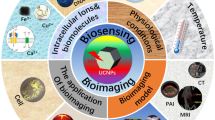Abstract
Photon upconverting nanophosphors (UCNPs) have the unique luminescent property of converting low-energy infrared light into visible emission which can be widely utilized in nanoreporter and imaging applications. For the use as reporters in these applications, the UCNPs must undergo a series of surface modification and bioconjugation reactions. Efficient purification methods are required to remove the excess reagents and biomolecules from the nanophosphor solution after each step to yield highly responsive reporters for sensitive bioanalytical assays. However, as the particle size of the UCNPs approaches the size of biomolecules, the handling of these reporters becomes cumbersome with traditional purification methods such as centrifugation. Here we introduce a novel approach for purification of bioconjugated 32-nm NaYF4: Yb3+, Er3+-nanophosphors from excess unbound biomolecules utilizing high gradient magnetic separation (HGMS)-system constructed from permanent super magnets which produce magnetic gradients in a magnetizable steel wool matrix amplifying the magnetic field. The non-magnetic biomolecules flowed straight through the magnetized HGMS-column while the UCNPs were eluted only after the magnetic field was removed. In the UCNPs the luminescent centers, i.e., lanthanide-ion dopants are responsible for the strong upconversion luminescence, but in addition they are also paramagnetic. In this study we have shown that the presence of these weakly paramagnetic luminescent lanthanides actually also enables the use of HGMS to capture the UCNPs without incorporating additional optically inactive magnetic core into them.




Similar content being viewed by others
References
Chen F, Zhang S, Bu W, Chen Y, Xiao Q, Liu J, Xing H, Zhou L, Peng W, Shi J (2012) A uniform sub-50 nm-sized magnetic/upconversion fluorescent bimodal imaging agent capable of generating singlet oxygen by using a 980 nm laser. Chem Eur J 18:7082–7090. doi:10.1002/chem.201103611
Evans CH, Tew WP (1981) Isolation of biological materials by use of erbium (III)-induced magnetic susceptibilities. Science 213:653–654
Frederikse H (2000) Properties of magnetic materials. In: Haynes WM (ed) CRC handbook of chemistry and physics, 91st edn. CRC, Boca Raton, pp 100–108
Gai S, Yang P, Li C, Wang W, Dai Y, Niu N, Lin J (2010) Synthesis of magnetic, up-conversion luminescent, and mesoporous core–shell-structured nanocomposites as drug carriers. Adv Funct Mater 45:2857–2865. doi:10.1002/adfm.200902274
Greenwood NN, Earnshaw A (1997) Chemistry of the elements. Pergamon Press, Oxford
Haase M, Schäfer H (2011) Upconverting nanoparticles. Angew Chem Int Ed Engl 50:5808–5829
Hatch GP, Stelter RE (2001) Magnetic design considerations for devices and particles used for biological high-gradient magnetic separation (HGMS) systems. J Magn Magn Mater 225:262–276
Jana NR, Earhart C, Ying JY (2007) Synthesis of water-soluble and functionalized nanoparticles by silica coating. Chem Mater 19:5074–5082
Li Z, Zhang Y, Shuter B, Muhammad Idris N (2009) Hybrid lanthanide nanoparticles with paramagnetic shell coated on upconversion fluorescent nanocrystals. Langmuir 25:12015–12018
Lilja H, Christensson A, Dahlen U, Matikainen MT, Nilsson O, Pettersson K, Lövgren T (1991) Prostate-specific antigen in serum occurs predominantly in complex with alpha 1-antichymotrypsin. Clin Chem 37:1618–1625
Moeser GD, Roach KA, Green WH, Alan Hatton T, Laibinis PE (2004) High-gradient magnetic separation of coated magnetic nanoparticles. AIChE J 50:2835–2848
Rantanen T, Järvenpää ML, Vuojola J, Arppe R, Kuningas K, Soukka T (2009) Upconverting phosphors in a dual-parameter LRET-based hybridization assay. The Analyst 134:1713–1716
Saleh SM, Ali R, Wolfbeis OS (2011) Quenching of the luminescence of upconverting luminescent nanoparticles by heavy metal ions. Chem Eur J 17:14611–14617
Sapsford KE, Tyner KM, Dair BJ, Deschamps JR, Medintz IL (2011) Analyzing nanomaterial bioconjugates: a review of current and emerging purification and characterization techniques. Anal Chem 83:4453–4488. doi:10.1021/ac200853a
Soukka T, Härmä H, Paukkunen J, Lövgren T (2001) Utilization of kinetically enhanced monovalent binding affinity by immunoassays based on multivalent nanoparticle–antibody bioconjugates. Anal Chem 73:2254–2260
Soukka T, Kuningas K, Rantanen T, Haaslahti V, Lövgren T (2005) Photochemical characterization of up-converting inorganic lanthanide phosphors as potential labels. J Fluoresc 15:513–528
Wang F, Liu X (2009) Recent advances in the chemistry of lanthanide-doped upconversion nanocrystals. Chem Soc Rev 38:976–989
Wilhelm S, Hirsch T, Scheucher E, Mayr T, Wolfbeis OS (2011) Magnetic nanosensor particles in luminescence upconversion capability. Angew Chem Int Ed Engl 50:A59–A62
Ylihärsilä M, Harju E, Arppe R, Hattara L, Hölsä J, Saviranta P, Soukka T, Waris M (2013) Genotyping of clinically relevant human adenoviruses by array-in-well hybridization assay. Clin Microbiol Infect 19:551–557. doi:10.1111/j.1469-0691.2012.03926.x
Zhou J, Yu M, Sun Y, Zhang X, Zhu X, Wu Z, Wu D, Li F (2010) Fluorine-18-labeled Gd(3+)/Yb(3+)/Er(3+) co-doped NaYF(4) nanophosphors for multimodality PET/MR/UCL imaging. Biomaterials 32:1148–1156. doi:10.1016/j.biomaterials.2010.09.071
Acknowledgments
This study was supported by the Academy of Finland (Grant No.: 140758) and Tekes, the Finnish Funding Agency for Technology and Innovation. The authors thank Emilia Harju and Minnea Tuomisto for synthesizing the upconverting nanophosphors. This work made use of the Aalto University Nanomicroscopy Center (Aalto-NMC) premises.
Author information
Authors and Affiliations
Corresponding author
Electronic supplementary material
Below is the link to the electronic supplementary material.
Rights and permissions
About this article
Cite this article
Arppe, R., Salovaara, O., Mattsson, L. et al. High gradient magnetic separation of upconverting lanthanide nanophosphors based on their intrinsic paramagnetism. J Nanopart Res 15, 1883 (2013). https://doi.org/10.1007/s11051-013-1883-z
Received:
Accepted:
Published:
DOI: https://doi.org/10.1007/s11051-013-1883-z




